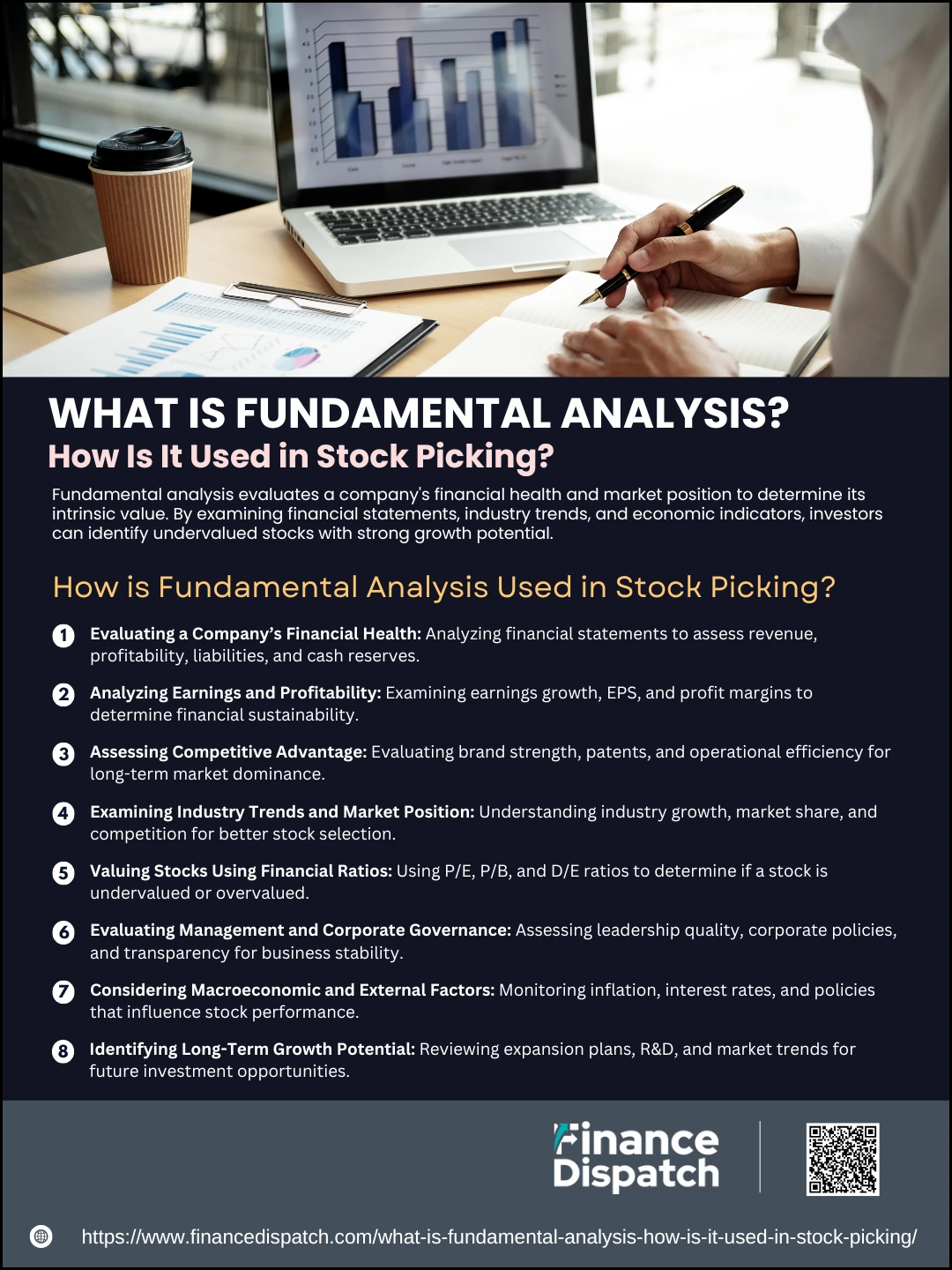Investing in the stock market requires more than just intuition—it demands a thorough understanding of a company’s financial health, industry position, and growth potential. This is where fundamental analysis comes into play. Fundamental analysis is a method used by investors to evaluate a stock’s intrinsic value by examining various financial and economic factors. Unlike technical analysis, which focuses on price trends and market patterns, fundamental analysis digs deep into a company’s earnings, assets, liabilities, and overall business model to determine whether its stock is fairly priced. By using this approach, investors can identify undervalued stocks with strong long-term growth potential or avoid overpriced stocks that may not sustain their market value. In this article, we will explore the key aspects of fundamental analysis and how it is effectively used in stock picking to make informed investment decisions.
What is Fundamental Analysis?
Fundamental analysis is a method used by investors and analysts to evaluate the intrinsic value of a stock by examining the financial and economic factors that influence a company’s performance. It involves assessing a company’s financial statements, management efficiency, industry position, and broader economic conditions to determine whether a stock is overvalued, undervalued, or fairly priced. Unlike technical analysis, which focuses on price movements and market trends, fundamental analysis is a long-term investment strategy that helps investors make informed decisions based on a company’s real worth. By studying factors such as earnings reports, revenue growth, profit margins, debt levels, and macroeconomic indicators, fundamental analysis provides a clearer picture of a company’s financial health and future growth potential. This approach is widely used by value investors looking for stocks that are trading below their actual value, offering opportunities for long-term gains.
 How is Fundamental Analysis Used in Stock Picking?
How is Fundamental Analysis Used in Stock Picking?
Fundamental analysis plays a crucial role in stock picking by helping investors determine whether a stock is worth buying, holding, or selling. It involves analyzing a company’s financial health, industry position, and macroeconomic factors to assess its long-term potential. By understanding a stock’s intrinsic value, investors can make informed decisions, avoiding overpriced stocks and capitalizing on undervalued opportunities. Below are the key ways fundamental analysis is applied in stock selection:
1. Evaluating a Company’s Financial Health
Investors analyze a company’s financial statements, including the income statement, balance sheet, and cash flow statement. These documents reveal key financial metrics such as revenue, profit margins, liabilities, and cash reserves, helping investors assess whether the company is financially stable and capable of long-term growth.
2. Analyzing Earnings and Profitability
A company’s ability to generate profits is a critical factor in stock selection. Investors examine Earnings Per Share (EPS), net income, and profit margins to determine if the company has a sustainable and growing revenue stream. A company with consistent earnings growth is often a strong investment.
3. Assessing Competitive Advantage
Companies with a strong market position tend to perform better over time. Investors evaluate factors such as brand strength, unique products, patents, and operational efficiency to determine if a company has a sustainable competitive edge. Businesses with high entry barriers and industry dominance tend to generate better returns.
4. Examining Industry Trends and Market Position
The performance of a stock is influenced by the overall industry and economic trends. Investors assess whether a company operates in a growing or declining industry, its market share, and how it stands against competitors. Stocks in expanding industries with high demand often present better long-term opportunities.
5. Valuing Stocks Using Financial Ratios
Investors use key valuation ratios such as the Price-to-Earnings (P/E) ratio, Price-to-Book (P/B) ratio, and Debt-to-Equity (D/E) ratio to determine if a stock is overvalued or undervalued. A stock with a low P/E ratio compared to its industry peers may indicate an undervalued opportunity, while a high P/E ratio may suggest overpricing.
6 Evaluating Management and Corporate Governance
The effectiveness of a company’s management team significantly impacts its success. Investors analyze leadership experience, corporate strategy, and governance policies to ensure the company is well-managed and operates with transparency. Strong leadership often leads to consistent business growth.
7. Considering Macroeconomic and External Factors
Broader economic conditions, such as inflation, interest rates, and government policies, affect stock prices. Investors monitor these factors to understand how they impact a company’s revenue and profitability. For example, high inflation can reduce consumer spending, affecting businesses in certain sectors.
8. Identifying Long-Term Growth Potential
Investors look at future growth prospects, such as expansion plans, research and development, and emerging market trends. Companies with innovative strategies and high demand for their products/services tend to offer better long-term investment potential.
 Key Components of Fundamental Analysis
Key Components of Fundamental Analysis
Fundamental analysis helps investors evaluate a company’s true worth by examining various financial and economic factors. This approach goes beyond stock price movements, focusing instead on the financial health, business model, industry position, and macroeconomic influences that impact a company’s performance. By understanding these components, investors can make well-informed decisions about whether a stock is undervalued, overvalued, or fairly priced. Below are the key components of fundamental analysis:
1. Quantitative Analysis
This aspect of fundamental analysis focuses on numerical data from a company’s financial statements. Investors examine revenue, net income, profit margins, and balance sheet health to determine financial stability. Key financial ratios, such as Price-to-Earnings (P/E) and Return on Equity (ROE), provide insight into valuation and profitability.
2. Qualitative Analysis
Beyond numbers, qualitative analysis assesses non-measurable factors such as a company’s business model, brand reputation, competitive edge, and leadership quality. A strong management team and a well-defined growth strategy can significantly impact a company’s success.
3. Financial Statements Analysis
Investors examine three main financial statements:
- Income Statement – Shows revenue, expenses, and net profit, helping investors evaluate profitability.
- Balance Sheet – Lists assets, liabilities, and shareholder equity to assess financial stability.
- Cash Flow Statement – Tracks cash inflows and outflows to ensure a company has sufficient liquidity.
4. Macroeconomic Factors
A company’s performance is influenced by external economic conditions such as inflation, interest rates, GDP growth, and government policies. These factors can impact consumer demand, production costs, and overall market conditions.
5. Industry and Market Conditions
Understanding the industry in which a company operates is essential. Investors evaluate market trends, competitive landscape, and sector-specific risks to determine if a company is positioned for long-term success or facing challenges.
6. Valuation Metrics
Valuation metrics help investors determine whether a stock is overvalued or undervalued. Some key valuation ratios include:
- Price-to-Earnings (P/E) Ratio – Compares stock price to earnings per share.
- Price-to-Book (P/B) Ratio – Measures a company’s stock price relative to its book value.
- Debt-to-Equity (D/E) Ratio – Evaluates financial leverage and risk level.
7. Growth Potential and Future Outlook
A company’s future growth prospects depend on innovation, market expansion, and long-term strategies. Investors assess factors such as new product development, strategic acquisitions, and industry disruptions that could impact the company’s growth trajectory.
Financial Statements: The Foundation of Fundamental Analysis
Financial statements are the backbone of fundamental analysis, providing a detailed view of a company’s financial health and operational performance. Investors rely on these statements to assess profitability, cash flow, and balance sheet strength, helping them make informed stock-picking decisions. By analyzing key metrics within these financial reports, investors can determine whether a company is financially stable, growing, or facing risks. Below is a breakdown of the three essential financial statements and their significance in fundamental analysis.
Key Financial Statements and Their Importance
| Financial Statement | Key Metrics | Importance in Fundamental Analysis |
| Income Statement | Revenue, Net Profit, Earnings Per Share (EPS), Gross & Operating Margins | Measures a company’s profitability and operational efficiency over a specific period. |
| Balance Sheet | Assets, Liabilities, Shareholders’ Equity, Debt-to-Equity Ratio | Provides insights into a company’s financial stability, liquidity, and capital structure. |
| Cash Flow Statement | Operating Cash Flow, Free Cash Flow, Investing & Financing Cash Flow | Evaluates a company’s liquidity and ability to sustain operations and growth. |
Important Ratios in Fundamental Analysis
Financial ratios are essential tools in fundamental analysis, helping investors assess a company’s financial health, profitability, valuation, and risk levels. These ratios provide a quantitative measure of a company’s performance, allowing investors to compare stocks within the same industry and identify potential investment opportunities. By analyzing key financial ratios, investors can determine whether a stock is undervalued, overvalued, financially stable, or at risk of financial distress. Some of the most commonly used ratios include the Price-to-Earnings (P/E) ratio, Debt-to-Equity (D/E) ratio, Return on Equity (ROE), and Dividend Yield. Each of these ratios serves a specific purpose, helping investors make informed stock-picking decisions based on solid financial data rather than market speculation.
Fundamental Analysis vs. Technical Analysis
Investors use two primary approaches to evaluate stocks: fundamental analysis and technical analysis. While both methods aim to guide investment decisions, they focus on different aspects of the market. Fundamental analysis examines a company’s financial health, industry position, and economic factors to determine its intrinsic value and long-term potential. In contrast, technical analysis relies on historical price movements, trading volume, and chart patterns to predict short-term price trends. Fundamental analysis is preferred by long-term investors who seek undervalued stocks, whereas technical analysis is often used by traders looking for short-term gains based on market behavior. The table below highlights the key differences between the two approaches.
Comparison of Fundamental and Technical Analysis
| Feature | Fundamental Analysis | Technical Analysis |
| Focus | Evaluates company’s intrinsic value | Analyzes stock price trends and patterns |
| Data Used | Financial statements, earnings, economic indicators | Charts, moving averages, volume data |
| Investment Style | Long-term investing | Short-term trading & speculation |
| Decision Factors | Revenue, profit margins, management quality, economic conditions | Support & resistance levels, momentum indicators, price action |
| Best Suited For | Investors looking for sustainable growth | Traders seeking quick market opportunities |
| Drawbacks | Time-consuming, affected by external economic factors | Ignores company fundamentals, prone to market noise |
 Common Mistakes to Avoid in Fundamental Analysis
Common Mistakes to Avoid in Fundamental Analysis
Fundamental analysis is a powerful tool for identifying strong investment opportunities, but even seasoned investors can make mistakes that lead to poor decisions. Errors in analyzing financial statements, misinterpreting key metrics, or ignoring external factors can result in buying overvalued stocks or missing out on profitable opportunities. To make informed and effective investment choices, it’s crucial to recognize and avoid common pitfalls. Below are some of the most frequent mistakes investors make in fundamental analysis.
1. Relying Solely on One Financial Metric
Many investors make the mistake of focusing only on a single metric, such as the Price-to-Earnings (P/E) ratio, while ignoring other key indicators like Debt-to-Equity (D/E) ratio, Return on Equity (ROE), and cash flow. A comprehensive analysis requires evaluating multiple metrics to get a complete picture of a company’s financial health.
2. Ignoring Industry and Market Trends
A company might appear financially strong, but if its industry is in decline or facing major disruptions, its future growth could be limited. Investors should consider broader market conditions, competitive landscape, and industry trends to determine if a company can sustain its success.
3. Overlooking Management Quality and Corporate Governance
A strong balance sheet is important, but poor management can still lead to a company’s downfall. Investors should assess the leadership team’s experience, strategic vision, and ethical track record to ensure the company is well-managed. Red flags such as frequent leadership changes or governance scandals can indicate deeper issues.
4. Failing to Adjust for Economic Conditions
Macroeconomic factors such as interest rates, inflation, and government policies can significantly impact a company’s performance. Investors who ignore these external factors may misjudge a company’s future potential and make risky investment decisions.
5. Misinterpreting Financial Statements
Financial statements can be complex, and failing to read them correctly can lead to misinformed conclusions. For example, focusing only on net profit without analyzing revenue growth, operating expenses, and debt levels can present an incomplete view of a company’s financial stability.
6. Overestimating Short-Term Market Reactions
Fundamental analysis is designed for long-term investing, but some investors panic over short-term price movements. A company’s stock may fluctuate due to temporary market events, but that doesn’t always reflect its true value. Patience and a long-term perspective are essential.
7. Ignoring Cash Flow Analysis
Many investors focus on profitability but ignore cash flow. Even profitable companies can face liquidity problems if their cash flow from operations is weak. Analyzing a company’s cash flow statement ensures it has sufficient cash to sustain operations and growth.
8. Not Comparing with Industry Peers
A stock may seem undervalued or overvalued based on standalone financial metrics, but comparing it with industry peers provides better context. Investors should assess whether a company’s financial ratios and growth rates align with sector benchmarks before making investment decisions.
9. Blindly Following Analyst Recommendations
Many investors rely too much on analyst ratings and stock recommendations without conducting their own research. While expert opinions can provide insights, blindly following them without verifying data can lead to misguided investments.
10. Neglecting Risk Management
Investing based on fundamental analysis does not eliminate risk. Investors should diversify their portfolios, set stop-loss limits, and consider potential downside risks before making stock purchases. Overexposure to a single stock or sector can lead to significant losses.
 Limitations of Fundamental Analysis
Limitations of Fundamental Analysis
Fundamental analysis is a valuable tool for evaluating a company’s financial health and long-term growth potential. However, it has certain limitations that investors must be aware of. While this approach provides deep insights into a company’s intrinsic value, it does not always account for market sentiment, short-term price fluctuations, or unpredictable economic events. Additionally, fundamental analysis requires significant time and effort, making it challenging for individual investors to conduct thorough research. Below are some of the key limitations of fundamental analysis.
1. Time-Consuming and Complex
Fundamental analysis requires a detailed examination of financial statements, industry trends, macroeconomic factors, and management quality. This level of research can be time-intensive and may not be practical for all investors, especially beginners.
2. Market Prices Do Not Always Reflect Intrinsic Value
Even if fundamental analysis suggests a stock is undervalued, market sentiment, speculation, and external factors can keep prices disconnected from intrinsic value for extended periods. A stock can remain overvalued or undervalued longer than an investor expects.
3. Difficulty in Predicting Market Timing
Unlike technical analysis, which focuses on price trends and trading patterns, fundamental analysis does not provide clear entry or exit points for buying and selling stocks. Investors may identify a great company but struggle with timing their investments effectively.
4. Subjectivity in Qualitative Analysis
While financial metrics are based on objective data, qualitative factors such as management effectiveness, brand reputation, and competitive advantage are more subjective. These factors rely on investor interpretation, which can lead to biases in stock evaluation.
5. External Factors Can Impact Performance
Fundamental analysis cannot always account for unexpected economic events, geopolitical risks, regulatory changes, or global crises that may affect a company’s performance. Even well-researched stocks can suffer due to external market conditions.
6. Does Not Consider Short-Term Trading Opportunities
Since fundamental analysis is focused on long-term investing, it is not well-suited for traders looking to profit from short-term price movements, momentum, or market trends. Technical analysis is often more effective for short-term trading strategies.
7. Financial Statements Can Be Manipulated
Companies can use accounting techniques to make their earnings, revenue, and debt levels appear better than they actually are. Investors relying solely on reported financial data may not always get an accurate picture of a company’s financial health.
8. Requires a Strong Understanding of Financial Data
To conduct effective fundamental analysis, investors need to be familiar with financial ratios, valuation metrics, and economic indicators. Without proper knowledge, misinterpretation of financial data can lead to poor investment decisions.
9. Limited Use in Speculative and Growth Stocks
Fundamental analysis is less effective when evaluating high-growth or speculative stocks, such as startups or companies with little historical financial data. These stocks may have high potential but lack the financial history needed for traditional analysis.
Conclusion
Fundamental analysis is a powerful tool for evaluating a company’s financial health, intrinsic value, and long-term growth potential. By examining financial statements, key ratios, industry trends, and macroeconomic factors, investors can make informed stock-picking decisions. However, it is not without its limitations—market sentiment, external economic events, and subjective factors can sometimes cause stock prices to deviate from their true value. While fundamental analysis is best suited for long-term investors, combining it with other strategies, such as technical analysis and risk management, can enhance decision-making. Ultimately, successful investing requires patience, thorough research, and a balanced approach to minimize risks and maximize returns.



